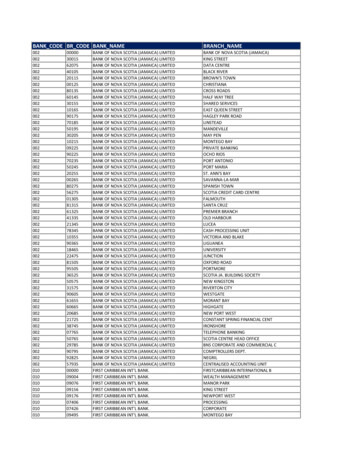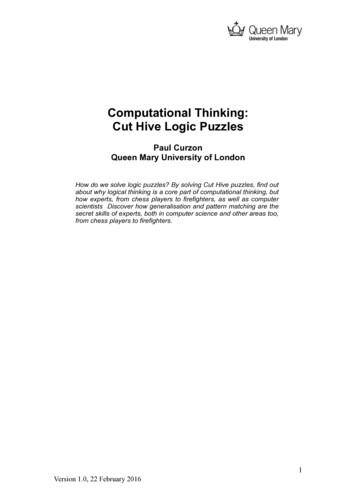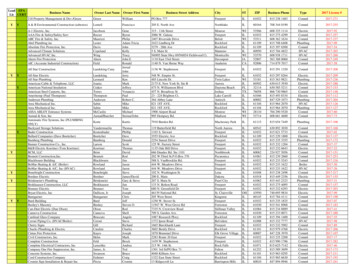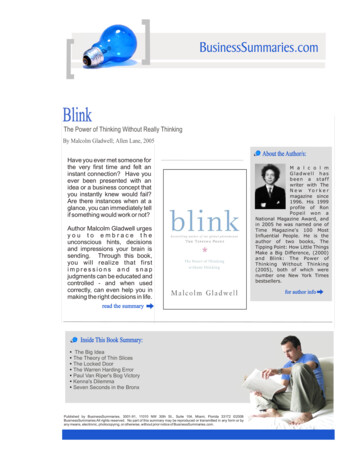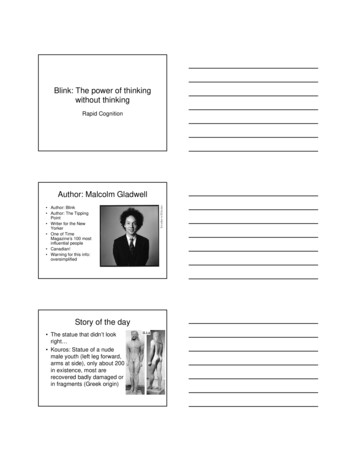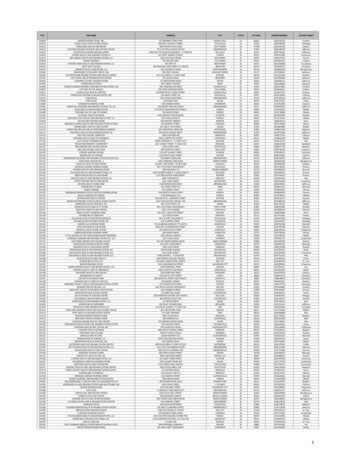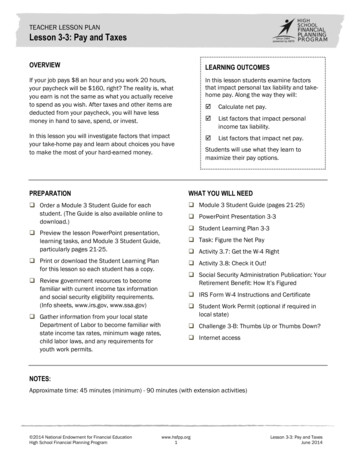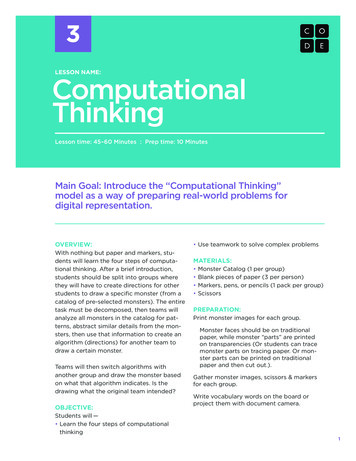
Transcription
3LESSON 3: COMPUTATIONAL THINKING3LESSON NAME:ComputationalThinkingLesson time: 45–60 Minutes : Prep time: 10 MinutesMain Goal: Introduce the “Computational Thinking”model as a way of preparing real-world problems fordigital representation.OVERVIEW:With nothing but paper and markers, students will learn the four steps of computational thinking. After a brief introduction,students should be split into groups wherethey will have to create directions for otherstudents to draw a specific monster (from acatalog of pre-selected monsters). The entiretask must be decomposed, then teams willanalyze all monsters in the catalog for patterns, abstract similar details from the monsters, then use that information to create analgorithm (directions) for another team todraw a certain monster.Teams will then switch algorithms withanother group and draw the monster basedon what that algorithm indicates. Is thedrawing what the original team intended?OBJECTIVE:Students will — Learn the four steps of computationalthinking Use teamwork to solve complex problemsMATERIALS: Monster Catalog (1 per group) Blank pieces of paper (3 per person) Markers, pens, or pencils (1 pack per group) ScissorsPREPARATION:Print monster images for each group. Monster faces should be on traditionalpaper, while monster “parts” are printedon transparencies (Or students can tracemonster parts on tracing paper. Or monster parts can be printed on traditionalpaper and then cut out.).Gather monster images, scissors & markersfor each group.Write vocabulary words on the board orproject them with document camera.1
3LESSON 3: COMPUTATIONAL THINKINGVOCABULARY:Computational Thinking—A method ofproblem-solving that helps computer scientists prepare problems for digital solutionsAbstraction—Removing details from a solution so that it can work for many problemsDecompose—To break a hard problem upinto smaller, easier onesPattern—A theme that is repeated manytimesProgram—Instructions that can be understood and followed by a machineAlgorithm—A list of steps that allow you tocomplete a taskComputationalthinking helpsmake light workof difficultproblems.2
3LESSON 3: COMPUTATIONAL THINKINGREVIEW:This review segment is intended to get the class thinking back to the last lesson. If you arecovering these activities out of order, please substitute your own review subjects here.Class Participation Questions: What does it mean to “repeat” a “block” of code? When might you use an “if” block?Elbow Partner Discussion: Can you think of a reason that you would want an if/else block, instead of just the “if”?INTRODUCE:Today, our class will become a group of elite teams of computer scientists. We will eachcomplete a real-world mission to come up with an “algorithm” that we can use to “program”our solution. Here is a brief overview of your mission (should you choose to accept it):We have been selected to help identify some monsters found on the planet Zuron. We needto describe these things based on descriptions that we already have of certain eye-witnessaccounts. There are quite a few monsters to describe, and it may seem challenging, but I’mgoing to give you some tools to help you out.To be successful in this operation, we will practice a method called Computational Thinking.Computational thinking uses four steps to help solve lots of different kinds of problems.Many people believe that computational thinking is all about getting solutions ready to runon a machine. That’s true, but it also helps make light work of difficult problems.Computer scientists often find that they’re in charge of programming solutions to thingsthat people have only ever dreamt of—things that have never been created before. Facinga problem that has never been solved can be scary, but with these simple tools, anythingis possible.Step 1) Decompose—We’re not just talking about zombies here. Instead, we’re talking aboutbreaking a big, bad problem down into something much more simple. Often, big problemsare just lots of little problems stuck together.Step 2) Patterns—Sometimes, when a problem has lots of little pieces, you will notice thatthe pieces have something in common. If they don’t, then they may at least have somestriking similarities to some pieces of another problem that has been solved before. If youcan spot these patterns, understanding your pieces gets much easier.Step 3) Abstraction—Once you recognize a pattern, you can “abstract out” (ignore) thedetails that make things different and use the general framework to find a solution that worksfor more than one problem.Step 4) Algorithms—When your solution is complete, you can write it up in a way that allowsit to be processed step by step, so that the results are easy to achieve.3
3LESSON 3: COMPUTATIONAL THINKINGACTIVITY: MAKE A MONSTEREach group gets a Monster Catalog. Each monster needs to be categorized based on theinformation that they are given in their Catalog. First, students will look at the monsters tosee what they all have in common, then they will abstract out the differences to create a listof instructions that anyone can use to re-create one of the monsters from the packet . . .without knowing ahead of time which one they are making!Getting someone to draw these monsters without seeing them can be quite challenging. Andif you look at the whole task, it may seem impossible. That makes this the perfect project forcomputational thinking.1) Decompose—What needs to be done to make the monster? Depending on the monster, it may already look like it’s decomposing, but now we need to“decompose” this task! Let’s break it up into smaller tasks, each will seem a little easier onits own. You may want to do this as a class together to get everyone on the same page.Example: Sort monsters by face shape Look for similarities in those monsters Make a list of features to identify Use identified features to create a new monster D escribe your new monster to your teammates in a step-by-step way and let themtry to put it together2) Patterns—What do those monsters have in common? What are some things that all of the monsters have? What are things that are similarbetween monsters of certain groups?Example: All monsters have heads Zombus Vegitas has a Vegitas mouth3) Abstraction —What’s different? Take it out. One monster may have Wackus Eyes, while another has Spritem Eyes, but they both haveeyes. That means we could say that “This monster has eyes” and later wewould be able to fill in the blank based on whatever monster we’ll be drawing.Example: Create a list of all the different features that the monsters with the details abstracted out ofthe sentence. The monster has ahead. The monster haseyes. The monster has anose. The monster hasears. The monster has amouth.4
3LESSON 3: COMPUTATIONAL THINKING4) Algorithm—How can you put this together to make a series of instructions that yourclassmates can follow? Now, each group should arrange their steps into a list that other groups can use torecreate a monster.Example:Create a list that you can fill out for your artist. Draw aWackum head. Draw Vegitas eyes. Draw a Wackum nose. Draw InHideum ears.* Draw a Spritem mouth.*InHideum means the Monster is missing that feature.Students should test their algorithm to see if it draws the correct picture. Then, let studentsswitch algorithms with another group, and draw the monster based on the algorithm(without seeing the original picture.) Did they create the right monster? Students canplay this over and over again, choosing to have classmates recreate monsters that alreadyexist, or describing new ones.5
3LESSON 3: COMPUTATIONAL THINKINGADJUSTMENTS:K-2: Try doing exercise as a class instead of small groups. Using transparencies with thefeatures printed on them (eyes, ears, nose) will make this much more manageable.3-5: Give students help when it comes to breaking down the problem and abstracting outdetails. It may be necessary to do a sample with them.6-8: Allow students to struggle for a while before offering suggestions. Let them “fail”a few times and let those failures provide the feedback they need to get it working.This age will likely enjoy the activity more if they are drawing the features, versusoverlaying transparencies.STEPS:1) Identify a problem.2) Break the problem down into little pieces.3) Abstract away details to identify a pattern that seems to be true for several pieces.4) Format each of the monsters as a list of instructions for drawing/building.5) Try solutions to make sure they work.6) Trade instructions so other groups can put all of the pieces together into one completework of art.RULES:1) If the monster is missing a feature, the category of that feature is “InHideum.”2) The category of the head shape determines the first half of the monster’s classification.3) The second half of the classification is determined by the category from the majorityof other features. I f there are equal amounts of features from multiple families, then categorize basedon the eyes.6
3LESSON 3: COMPUTATIONAL THINKING3Monster Catalog7
3LESSON 3: COMPUTATIONAL THINKINGClassified MonstersThis is the Zombus Vegitas, so calledbecause of it’s “Zombus” head classificationand its dominance of “Vegitas” features.Zombus VegitasThis is the Franken Wackus. Notice his“Franken” head shape and majority of“Wackus” features.Franken WackusThis is a monster from the Happy Spritemfamily. Her head has a distinct “Happy”shape, while her facial features are of the“Spritem” categorization.Happy Spritem8
3LESSON 3: COMPUTATIONAL ckusSpritemEyesEarsNoseMouth9
3LESSON 3: COMPUTATIONAL THINKINGAlign marks here10
3LESSON 3: COMPUTATIONAL THINKINGAlign marks here11
3LESSON 3: COMPUTATIONAL THINKINGAlign marks here12
3LESSON 3: COMPUTATIONAL THINKINGAlign marks here13
3LESSON 3: COMPUTATIONAL THINKINGAlign marks here14
3LESSON 3: COMPUTATIONAL THINKINGAlign marks here15
3LESSON 3: COMPUTATIONAL THINKINGAlign marks here16
3LESSON 3: COMPUTATIONAL THINKINGAlign marks here17
3LESSON 3: COMPUTATIONAL THINKINGAlign marks here18
3LESSON 3: COMPUTATIONAL THINKINGAlign marks here19
3LESSON 3: COMPUTATIONAL THINKINGAlign marks here20
3LESSON 3: COMPUTATIONAL THINKINGAlign marks here21
3LESSON 3: COMPUTATIONAL THINKINGAlign marks here22
3LESSON 3: COMPUTATIONAL THINKINGAlign marks here23
without knowing ahead of time which one they are making! Getting someone to draw these monsters without seeing them can be quite challenging. And if you look at the whole task, it may seem impossible. That makes this the perfect project for computational thinking. 1) Decompose—What needs to be done to make the monster? Depending on the monster, it may already look like it’s decomposing .
